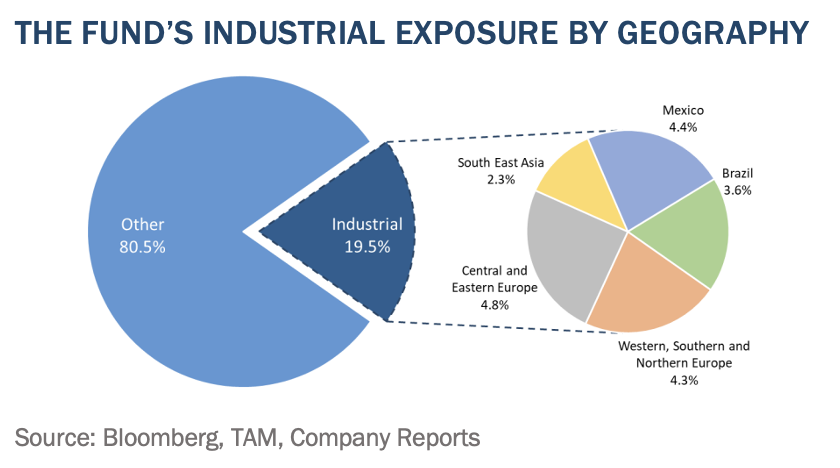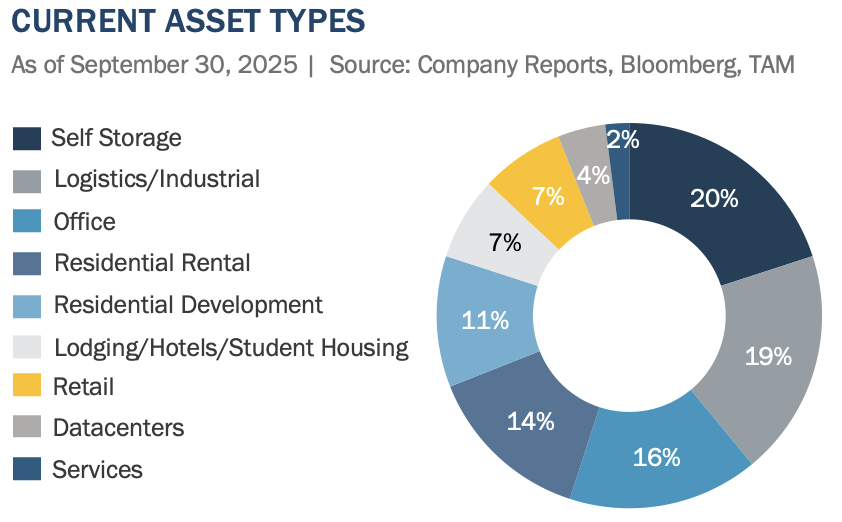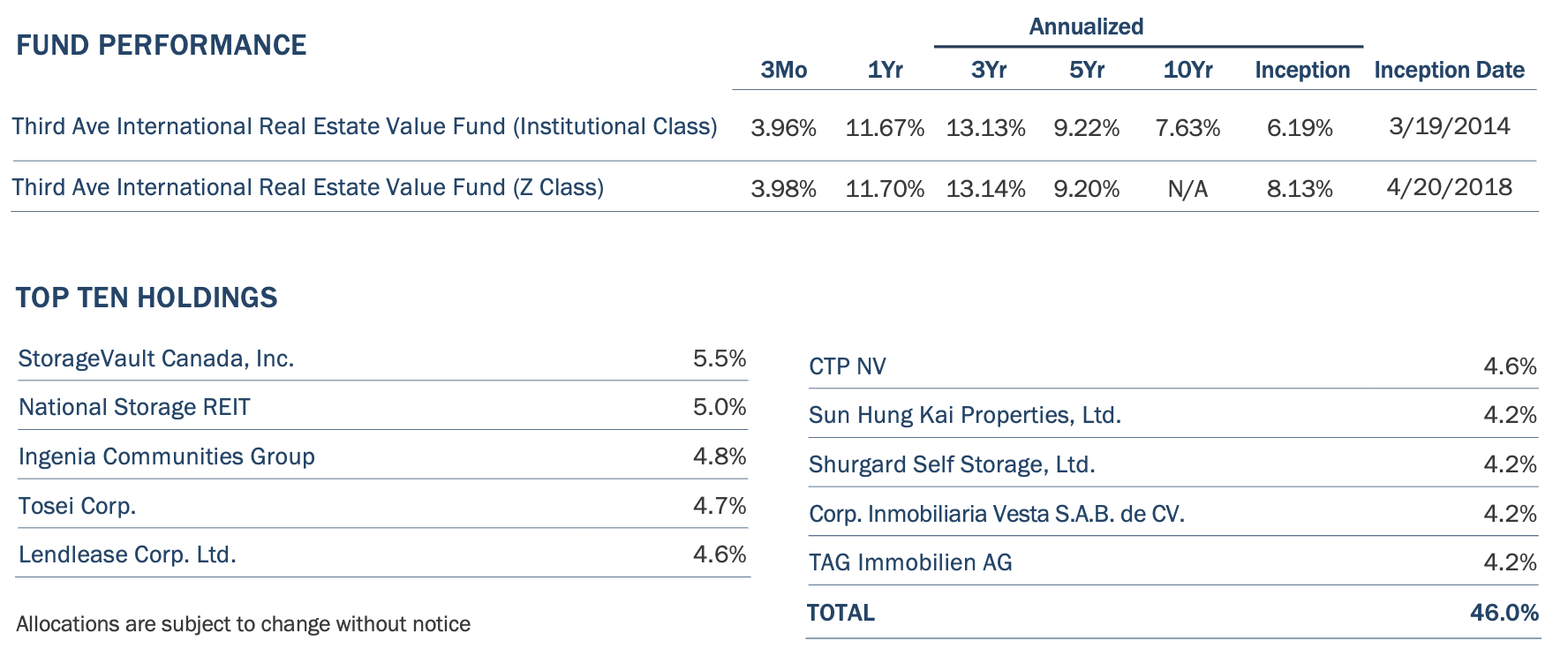International Real Estate Value Fund Q325
Dear Fellow Shareholders,
We are pleased to provide you with the Third Avenue International Real Estate Value Fund’s (the “Fund”) report for the quarter ended September 30, 2025. During the quarter, the Fund generated a return of +3.96% (after fees) compared to the most relevant benchmark, the FTSE EPRA/NAREITEIT Global ex US Index1 (the “Index”), which returned +4.03% (before fees) for the same period.

ACTIVITY
The Fund takes a cautious approach when investing in listed real estate companies with significant emerging market exposure. For instance, some of the specific requirements that need to be met to warrant an investment include experienced management teams that are aligned with minority shareholders, in addition to a well-capitalized balance sheet with sufficient liquidity and an added emphasis on local banking relationships. Not only that, for a company to be included in the Fund, it will need a history of making smart capital allocation decisions that create value for shareholders, as well as a focus on high-quality real estate that should benefit from cyclical or structural growth trends over time.
All of these factors are evident in fund holding CTP NV (“CTP”), which is based in the Netherlands (a developed market) but has approximately 35% of its exposure in Eastern Europe (that is classified as ‘emerging’). More specifically, CTP owns, manages, and develops high-quality industrial real estate across 13.5 million square meters, mainly in Central and Eastern Europe. The company also has a pipeline under development that covers 2 million square meters, and a substantial landbank for future projects could add 13 million square meters.
CTP hosted a capital markets day for investors during the quarter, highlighting persistently strong growth rates in most fundamental metrics. CTP management’s presentations emphasized that (i) the secular trend of ‘nearshoring,’ where manufacturing and supply chains move closer to the end consumer, remains strong; (ii) strong tenant demand amid limited competition leading to high returns, as shown by CTP’s +16% return on equity; and (iii) in light of this, growth targets were raised, which could lead to mid-teens earnings per share growth over the next five years, by their estimates.
Another interesting theme from the capital markets day related to the expansion of Asian-based manufacturers into Europe. CTP pointed out that leasing to Asian-headquartered customers has increased, now making up 20% of leasing, up from previous levels of about 10%. Much of this demand has been driven by a desire among multinationals and manufacturers to diversify their manufacturing and supply chains beyond China. This trend, often called a ‘China plus one’ strategy, aims to reduce risk from reliance on a single market and has accelerated due to geopolitical tensions, higher costs in China, and the COVID-19 pandemic's impact on supply chain disruptions.
While CTP experiences increased demand in Europe, Southeast Asian countries like Malaysia, Thailand, and Vietnam are likely the biggest winners from this diversification strategy due to their proximity to China, low costs, and large workforce. Recognizing this trend, many of CTP’s tenants have asked CTP to consider Vietnam as a potential expansion market, especially since the first half of this year saw a 33% rise in total registered foreign investment in Vietnam.3
Other Southeast Asian markets are also experiencing growth in their manufacturing base as geopolitical uncertainty increases the ‘China plus one’ manufacturing strategy. In the first half of this year, Thailand experienced a surge in foreign direct investment, with 132% growth over the previous period.3

The increase in foreign investment applications in Thailand seems to be emanating from China, with many prospective investments focusing on high-tech manufacturing, such as electric vehicles, data centers, and smart electronics. Most of this capital is expected to flow into Thailand’s Eastern Economic Corridor (“EEC”), which offers advantageous logistics infrastructure, a skilled workforce, and deep existing supply chains. The government also provides several pro-business incentives to attract investments into the EEC.
With these strong structural growth drivers, alongside Fund Management’s measured emerging market investment approach, the Fund initiated an investment in Thailand-listed Amata Corporation (“Amata”). Amata specializes in developing and managing large-scale industrial estates in Thailand and Vietnam. Founded in 1989 by its current Chairman and CEO, Amata focuses on planning, developing, and marketing industrial hubs, offering tenants and owner-occupiers infrastructure, utilities, and services. Amata currently operates two leading estates in Thailand's EEC. Its Vietnam subsidiary has been active since 1994, managing four major industrial estates covering over 7,000 acres.
Amata has capitalized on the investment boom in Thailand and Vietnam, increasing earnings by 20% annually over the past three years while maintaining a strong balance sheet. Despite this attractive growth, the Fund bought shares at appealing valuations, including around half of a conservative net-asset value (“NAV”) estimate and a 6 times price-to-earnings ratio compared to a ten-year average of 12 times. Such a discounted multiple seems inconsistent with Amata’s growth potential. It also conflicts with its risk profile given Amata’s focus on integrated estate development has significantly increased its recurring income sources such as rents, utilities, and service fees, which now comprise around half of its earnings.

The unusual discount in Amata’s share price appears to be due to uncertainty surrounding U.S. trade policy. However, recent agreements, including a 19% tariff on Thailand’s exports, seem unlikely to affect the ‘China plus one’ structural shift as a key growth driver for Southeast Asia, particularly as China-US geopolitical tensions seem to be increasing. The surge in Foreign Direct Investment (“FDI”) supports this, and shares should respond positively as Amata implements its growth strategy, supported by a ~6% dividend yield.
The investment in Amata also enhances the Fund’s overall industrial real estate exposure, which favors companies aligned with ‘nearshoring’ or ‘China plus one’ long-term trends. As shown in the Fund's Industrial Exposure by Geography chart on the next page, the Fund has a 20% exposure to industrial real estate. More than half of the companies included in that 20% are invested in the primary beneficiaries of nearshoring and ‘China plus one’, including Central and Eastern Europe, Mexico, and Southeast Asia.

This level of geographic diversity within the Fund’s industrial real estate exposure extends across the entire Fund, as shown by the Fund’s regional exposure chart below. The Asia Pacific region (Asia, including Japan and Australia) now makes up half of the Fund’s assets, with the UK and Europe together accounting for about one-third, and the remainder in Canada and Latin America.


FUND COMMENTARY
While the investment in Amata augmented the Fund’s industrial nearshoring and logistics exposure, the Fund’s other key investment themes remain equally as compelling, in Fund Management’s view, and include (i) Deep-Value and Special Situations as discussed in, (ii) undersupplied residential markets, and (iii) immature self-storage.
Accounting for 20% of the Fund’s overall exposure, immature self-storage remains a high-conviction position. As discussed in the Fund’s third quarter 2024 letter, there are several key reasons supporting our thesis, including: (i) low portfolio occupancies that are caused by recent development or acquisitions, with lease-up likely to drive significant earnings growth; (ii) self-storage is fundamentally under-supplied outside the U.S., and developing new assets is complex due to planning constraints; (iii) the long-term demand outlook for self-storage is generally positive as consumer awareness improves and urbanization continues; (iv) a turnaround in housing market activity as interest rates decline will likely boost occupancy and earnings; and (v) international self-storage trades at attractive, discounted valuations relative to private market valuations, while U.S. self-storage REITs trade at premiums despite the industry’s maturity.
A final advantage, which is less common in many commercial real estate asset classes, is the significant benefit of achieving scale in self-storage operations, or gaining ‘platform value’ within this operationally intensive property type. In this context, the Fund Management team was very interested in seeing Fund holding Shurgard Self Storage Ltd. (“Shurgard”) publish a presentation highlighting the financial benefits of leveraging the company's platform during a recent acquisition. Shurgard, which owns and manages 338 self-storage assets across the UK and Europe, purchased the UK self-storage portfolio ‘Lok N Store’ a year ago in a £600 million4 transaction. Since then, leveraging the Shurgard management platform has led to several financial benefits, including an increase in occupancy from 67% to 77%, a reduction in staff per self-storage asset from 3.8 to 2.5, a head office staff reduction of 13 people, and the remixing and extension of assets to increase the number of units by about 4%.
With such strong potential for scalability, long-term growth drivers, and the ability to add value, it is no surprise that, after the quarter ended, the Fund holding Big Yellow Group PLC (“Big Yellow”) announced that the Private Equity group Blackstone Europe LLP (“Blackstone”) is considering a cash offer to acquire the company outright. Big Yellow owns and manages a portfolio of 109 self-storage assets, mostly in and around London, with 14 additional assets in various stages of development.
Highlighting some of the unusual price-to-value discrepancies in international real estate, Big Yellow’s share price offered 45% upside to Fund Management's assessed £14.4 net asset value before the announcement. In fact, independent property appraiser JLL conducted assessments of Big Yellow’s portfolio value (which were signed off in the annual accounts in March 31, 2025) that supported a £13.6 net asset value.5 Importantly, JLL’s appraisals were conducted individually. Still, if sold as a portfolio, JLL’s view was that there would be additional upside from a portfolio premium, likely recognizing a self-storage operating portfolio's inherent ‘platform value’.
While it's uncertain whether Blackstone will make a formal offer to Big Yellow, the UK macroeconomic situation and ongoing budget uncertainties could prevent any privatization from proceeding. However, Fund Management’s experience with other Blackstone privatization efforts has been positive. For example, the 2017 privatization of Spanish Lodging REIT Hispania occurred at a 53% premium to the Fund’s cost basis, and the June 2021 privatization of UK diversified property company St. Modwen was at a 73% premium.
Because of its attractive long-term growth potential, Big Yellow appears especially appealing to a diverse group of potential investors, including Blackstone. While not all encompassing, some of these factors include: (i) the founders (Chairman and CEO), who control +4% of shares and are not as involved in the day-to-day operations as years prior (ii) a conservative balance sheet with only a 13% net debt to capital ratio, (iii) the platform's value given the scarcity of large-scale self-storage portfolios, and (iv) significant earnings potential from lease-ups, development, and possible acquisitions over the medium term (with public markets providing a straightforward exit strategy once the portfolio stabilizes at higher occupancy).
Many of the Fund’s 25 holdings share similar characteristics to Big Yellow. Therefore, Fund Management remains of the view that privatizations will likely continue if public markets do not recognize the value inherent in many of these holdings. As such, Fund Management remains quite constructive on the outlook for the Fund.
We thank you for your continued support and look forward to writing to you again next quarter. In the interim, please don’t hesitate to contact us with any questions, comments, or ideas at realestate@thirdave.com.
Sincerely, The Third Avenue Real Estate Value Team
Quentin Velleley, CFA Portfolio Manager

IMPORTANT INFORMATION
This publication does not constitute an offer or solicitation of any transaction in any securities. Any recommendation contained herein may not be suitable for all investors. Information contained in this publication has been obtained from sources we believe to be reliable, but cannot be guaranteed.
The information in this portfolio manager letter represents the opinions of the portfolio manager(s) and is not intended to be a forecast of future events, a guarantee of future results or investment advice. Views expressed are those of the portfolio manager(s) and may differ from those of other portfolio managers or of the firm as a whole. Also, please note that any discussion of the Fund’s holdings, the Fund’s performance, and the portfolio manager(s) views are as of September 30, 2025 (except as otherwise stated), and are subject to change without notice. Certain information contained in this letter constitutes “forward-looking statements,” which can be identified by the use of forward-looking terminology such as “may,” “will,” “should,” “expect,” “anticipate,” “project,” “estimate,” “intend,” “continue” or “believe,” or the negatives thereof (such as “may not,” “should not,” “are not expected to,” etc.) or other variations thereon or comparable terminology. Due to various risks and uncertainties, actual events or results or the actual performance of any fund may differ materially from those reflected or contemplated in any such forward-looking statement. Current performance results may be lower or higher than performance numbers quoted in certain letters to shareholders.
Date of first use of portfolio manager commentary: October 14, 2025
FUND RISKS: In addition to general market conditions, the value of the Fund will be affected by the strength of the real estate markets. Factors that could affect the value of the Fund’s holdings include the following: overbuilding and increased competition, increases in property taxes and operating expenses, declines in the value of real estate, lack of availability of equity and debt financing to refinance maturing debt, vacancies due to economic conditions and tenant bankruptcies, losses due to costs resulting from environmental contamination and its related clean-up, changes in interest rates, changes in zoning laws, casualty or condemnation losses, variations in rental income, changes in neighborhood values, and functional obsolescence and appeal of properties to tenants. The Adviser’s use of its ESG framework could cause it to perform differently compared to funds that do not have such a policy. The criteria related to this ESG framework may result in the Fund’s forgoing opportunities to buy certain securities when it might otherwise be advantageous to do so, or selling securities for ESG reasons when it might be otherwise disadvantageous for it to do so. For a full disclosure of principal investment risks, please refer to the Fund’s Prospectus.
1 FTSE EPRA/NAREIT Global ex US Index is designed to track the performance of listed real estate companies and Real Estate Investment Trusts in both developed and emerging markets. By making the index constituents free-float adjusted, liquidity, size and revenue screened, the series is suitable for use as the basis for investment products, such as derivatives and Exchange Traded Funds (ETFs). It is not possible to invest directly in an index.
2 Excess Return refers to the return from an investment above the benchmark. Source: Investopedia
3 Source: McKinsey
4 Equivalent to approximately USD 811 million, based on a GBP/USD exchange rate of 1.3513 as of September 30, 2025.
5 The JLL valuation resulting in a £13.6 net tangible assets per share assumes that a purchaser would incur costs as a corporate structure, equating to 2.75% of costs as a proportion of gross asset value.
For the Third Avenue Glossary please visit here.

Past performance is no guarantee of future results; returns include reinvestment of all distributions. The chart represents past performance and current performance may be lower or higher than performance quoted above. Investment return and principal value fluctuate so that an investor’s shares, when redeemed, may be worth more or less than the original cost. For the most recent month-end performance, please visit the Fund’s website at www.thirdave.com. The gross expense ratio for the Fund’s Institutional and Z share classes is 1.54% and 1.48%, respectively, as of March 1, 2025.
Distributions and yields are subject to change and are not guaranteed.
The fund's investment objectives, risks, charges, and expenses must be considered carefully before investing. The prospectus contains this and other important information about the investment company, and it may be obtained by calling 800-443-1021 or visiting www.thirdave.com. Read it carefully before investing.
Distributor of Third Avenue Funds: Foreside Fund Services, LLC.
Third Avenue offers multiple investment solutions with unique exposures and return profiles. Our core strategies are currently available through '40Act mutual funds and customized accounts. If you would like further information, please contact a Relationship Manager at:










